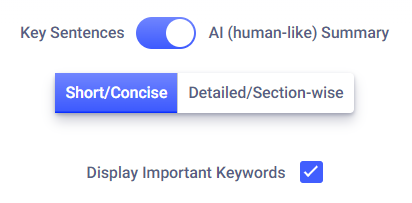If you’ve followed my blog over the last several years, you might remember that I occasionally create challenges for myself to explore, learn, and share what I discover. Last December, I challenged myself to explore 24 Days of Teaching and Learning Resources.
My challenge for April is to explore something new each day and share what I discover. Hopefully, I won't let you or myself down! (April Challenge Update Doc)
Today I want to catch up on some Edutopia posts. Edutopia has long been one of my favorite resources to explore and reflect on teaching and learning.
Before I share the posts I explored, I wanted to share a tool I am using to create "Too Long; Didn't Read" summaries. I've always loved the way the TeacherBetter Blog starts most posts with a TLDR summary. TLDR This is an online tool that summarizes links or pasted text. There are a couple of different ways to set each summary up and I am trying them all. I've included the summary settings I used for each TLDR summary. There is also a Chrome Extension, but I have not experimented with this yet.
I am reading each article, but I wanted to model some of the ways you can use a summarizing tool to get an idea about an article before diving in by sharing the TLDR summaries. I copied sections of text for the first 4 instead of just the article link to challenge TLDR to summarize without a title possibly bias the summary.
How to Promote the Intrinsic Desire to Learn
TLDR:
Researchers have made it, that motivation is one of the keystones of teaching and learning. Intrinsic motivation leads to greater academic achievement and a better sense of well-being. Research has found that motivation driven by extrinsic factors tends to lead to “decreased well- being”
Keywords: Motivation | Teaching | Learning | Researchers | Keystones
6 Counterintuitive Strategies to Boost Student Learning
TLDR:
Sometimes the best practices aren’t obvious—they challenge cherished notions, upend decades of conventional wisdom, or just feel kind of eccentric.
Our research has shown that if you think positive emotions are always positive for learning and negative emotions are always negative for learning—that’s not true.”
In fact, if you’re not sometimes frustrated or struggling, he told Edutopia in a 2022 interview, “that means you’re probably not learning.”
QUIZ STUDENTS BEFORE THEY LEARN THE MATERIAL Asking students to take a practice test before they’ve even encountered the material on the test might seem cruel.
Making a lot of mistakes on pretests is key to the strategy’s success, the researchers concluded, as it spurs students’ curiosity and pushes them to search for the right answers when they finally do encounter the new material.
But there are ways to take ownership of the pent-up energy students often have—to determine when it’s allowed and designate parts of the school day during which it can be released.
The Case for Instructional Coaching Throughout a Teacher’s Career
TLDR:
The process of instructional coaching can look quite different from school to school. The training of instructional coaches is likely to be just as inconsistent. Once teachers become certified, there is often an unspoken assumption that they no longer need coaching unless they are struggling. Often, the lack of coaching is perceived as a benefit.
Keywords: Instructional Coaching | School | Training | Different | Likely
Why the 100-Point Grading Scale Is a Stacked Deck
TLDR:
Grades are a staple of American education, but they’re a fairly modern invention.
At that critical juncture of our grading history, the 100-point and A–F grading systems were independent: The former was designed to rank students within a university setting, the latter to normalize academic marks in public school settings.
Even if they scored 90s on the next seven assignments—a clear plurality of outstanding work—they’d still end up with an 80, the equivalent of a B- or C+ in most grading systems.
But Carifio and Carey found the opposite to be true.
The assigning of even a small number of catastrophically low grades, especially early in the marking term, before student self-efficacy can be established, can create this sense of helplessness,” Carifio and Carey explain, putting students in an impossible situation and discouraging them for the rest of the grading period.
“This irritated the kids at first, but over time they began to focus on their actual performance,” writes Frommert.
Keywords: Students | Grades | Carifio | Carey | Assignments
13 Formative Assessments That Inspire Creativity
TLDR:
It’s always better to know if a student is struggling before a big test is in the rearview mirror.
Simple Symbols: Sketchnoting—simple, hand-drawn renderings of things like facts, dates, or abstract concepts—can be a great way to help students process vocabulary.
This process of explanation can open students' eyes to what they know and what they don't, explains Woo-Kyoung Ahn, a psychology professor at Yale University who uses a similar strategy with college students before exams.
asks health ed content specialist Christopher Pepper.
How large/small should I draw these parts?
Invite students to draw a picture that illustrates a relationship between terms from the lesson or recreates a scene from their reading.
Bookmarked to Explore Soon
- How Tone of Voice Shapes Your Classroom Culture
- 4 Ways to Make Classroom Participation More Inclusive
- Creating an Inclusive Classroom for Neurodivergent Learners
- A Collaborative Approach to Mistake Analysis
- 10 Powerful Ways to End Your Lessons

Visit the blog tomorrow for something new or follow along in this document.











.png)

No comments:
Post a Comment